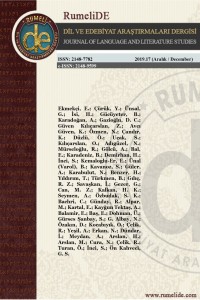Abstract
Recently, we see that the ancient texts in the field of literature are re-read and evaluated with different approaches and techniques. Literary researchers often point out that literary texts should be explicitly processed in today's perceptions and interpretations using western-referenced methods. Investigations on the aesthetic dimensions of texts based on fiction are valuable in terms of a new horizon. Especially the new literature that develops in the narrative world prepares the ground for such studies. Since mesnevi, which is one of the literary texts connected to narration, is created by adhering to aesthetic rules, it is accepted as romans or novel and is re-read according to these genres. The narrative planes, mesnevi with their lower and upper fictional identity can be interpreted in terms of these new perspectives. Mesnevi carries a rich material in terms of image and symbol in terms of aesthetic narrative dimension. The language phenomenon in the narrative focuses on character drawing rather than plot. Accordingly, creating a new narrative plane based on the known texts and events of the past is a priority for the narrator. The interrelated fictional units of Yusuf and Zeliha mesnevi point to a structure of secondary events connected to the main event within the text integrity. In this narrative composition based on the sacred text, the language and expression patterns used by the artist necessitate being literally “literary". In this context, our study is to reveal the narrator's aesthetic attitude in Shayyad Hamza's mesnevi in Yusuf and Zeliha; to compare the traditional with the modern in terms of language and expression, to examine the mythical and mystical structure.
References
- Aktaş, Ş. (1991). Roman Sanatı ve Roman İncelmesine Giriş. Ankara: Akçağ. Bayram, Y. (2017). Bildungsroman Örneği Olarak Hüsn ü Aşk. İlmi Araştırmalar(23), 7-28. Campbell, J. (2000). Kahramanın Sonsuz Yolculuğu . (S. Gürses, Çev.) İstanbul: Kabalcı. Çetin, N. (2003). Roman Çözümleme Yöntemi. Anara: Öncü Basımevi. Eliade, M. (1994). Ebedi Dönüş Mitosu. (Ü. Altuğ, Çev.). (Ü. Altuğ, Çev.) Ankara: İmge Kitabevi. Joseph, C. (2010). Kahramanın Sonsuz Yolculuğu. (S. Gürses, Çev.) İstanbul: Kabalcı. Kernberg, O. (1999). Sınır Durumlar ve Patolojik Narsisizm. (M. Atakay, Çev.) İstanbul: Metis . Lukacs, G. (2007). Roman Sanatı. (C. Soydemir, Çev.) İstanbul: Metis. Narlı, M. (2007). Şiir ve Mekân. Ankara: Hece. Ricouer, P. (2007). Zaman ve Anlatı: Bir. (M. Rifat, & S. Rıfat, Çev.) İstanbul: YKY. Sağlık, Ş. (2010). Popüler Roman Estetik Roman, Akçağ Yay., Ankara. Ankara: Akçağ. Taş, İ. (2010). Şeyyad Hamza Yusuf ve Zeliha. Ankara: ekitap.kulturturizm.gov.tr. Tökel, D. A. (2009). Bir Bildungsroman Olarak Leyla vü Mecnun Mesnevisi. İstanbul: Kesit. Tökel, D. A. (2011). Kurmacadan Anlatıya: Kendisi Kendisi İçin Olmayan Metin Olarak Mesnevi. H. Aynur içinde, Eski Türk Edebiyatı Çalışmaları VI, Mesnevi: Şiirin Hikayesi (s. 171). İstanbul: Turkuaz. Uçak, S. (2015). Hâşimî’nin Mihr ü Vefâ Mesnevisinin Tenkitli Metni ve İncelemesi. Yayımlanmamış Doktora Tezi. Elazığ: Fırat Ünv. Sosyal Bilimler Enstitüsü.
Abstract
Son zamanlarda edebiyat sahasındaki kadim metinlerin farklı yaklaşım ve tekniklerle yeniden okunup değerlendirildiğini görmekteyiz. Edebiyatçılar, edebi metinlerin batı referanslı yöntemlerle günümüz algı ve yorumlamalarına açık bir formda işlenmesi gerektiğini sıklıkla dile getirmektedir. Kurguya bağlı metinlerin estetik boyutlarına dair yapılan incelemeler, yeni bir ufuk açısından kıymetlidir. Özellikle anlatı dünyasına ait gelişen yeni literatür, bu tür çalışmalara zemin hazırlamaktadır. Anlatmaya bağlı edebi metinlerden mesnevi, estetik kurallara bağlı kalınarak oluşturulduğu için günümüzde romans veya roman olarak kabul edilip bu türlere göre yeniden okunmaktadır. Anlatı düzlemleri, alt ve üst kurmaca kimliğiyle mesnevi, bu bahsettiğimiz yeni bakış açıları bakımından yorumlanabilmektedir. Mesnevi, estetik anlatı boyutu itibariyle imaj ve imge açısından zengin bir malzeme taşımaktadır. Anlatıdaki dil olgusu, olay örgüsünden çok, karakter çizimi üzerinde yoğunlaşır. Buna göre geçmişe ait bilinen metin ve olaylardan hareketle yeni bir anlatı düzlemi oluşturmak, anlatıcı için daha öncelikli bir konudur. Yûsuf ve Zelîhâ mesnevisinin birbiriyle ilgili kurgusal birimleri, metin bütünlüğü içinde ana olaya bağlı tali olayların oluşturduğu bir yapıya işaret eder. Kutsal metinden hareketle oluşturulan bu anlatı kompozisyonunda sanatçının kullandığı dil ve ifade kalıpları, tam anlamıyla “edebî” olmayı zorunlu kılar.Bu bağlamda çalışmamız, Şeyyad Hamza’nın Yûsuf ve Zelîhâ mesnevisinde anlatıcının estetik tavrını ortaya koymak; dil olgusu ve anlatım açısından geleneksel olanla modern olanı karşılaştırmak, mitik ve mistik yapıyı irdelemektir.
Keywords
References
- Aktaş, Ş. (1991). Roman Sanatı ve Roman İncelmesine Giriş. Ankara: Akçağ. Bayram, Y. (2017). Bildungsroman Örneği Olarak Hüsn ü Aşk. İlmi Araştırmalar(23), 7-28. Campbell, J. (2000). Kahramanın Sonsuz Yolculuğu . (S. Gürses, Çev.) İstanbul: Kabalcı. Çetin, N. (2003). Roman Çözümleme Yöntemi. Anara: Öncü Basımevi. Eliade, M. (1994). Ebedi Dönüş Mitosu. (Ü. Altuğ, Çev.). (Ü. Altuğ, Çev.) Ankara: İmge Kitabevi. Joseph, C. (2010). Kahramanın Sonsuz Yolculuğu. (S. Gürses, Çev.) İstanbul: Kabalcı. Kernberg, O. (1999). Sınır Durumlar ve Patolojik Narsisizm. (M. Atakay, Çev.) İstanbul: Metis . Lukacs, G. (2007). Roman Sanatı. (C. Soydemir, Çev.) İstanbul: Metis. Narlı, M. (2007). Şiir ve Mekân. Ankara: Hece. Ricouer, P. (2007). Zaman ve Anlatı: Bir. (M. Rifat, & S. Rıfat, Çev.) İstanbul: YKY. Sağlık, Ş. (2010). Popüler Roman Estetik Roman, Akçağ Yay., Ankara. Ankara: Akçağ. Taş, İ. (2010). Şeyyad Hamza Yusuf ve Zeliha. Ankara: ekitap.kulturturizm.gov.tr. Tökel, D. A. (2009). Bir Bildungsroman Olarak Leyla vü Mecnun Mesnevisi. İstanbul: Kesit. Tökel, D. A. (2011). Kurmacadan Anlatıya: Kendisi Kendisi İçin Olmayan Metin Olarak Mesnevi. H. Aynur içinde, Eski Türk Edebiyatı Çalışmaları VI, Mesnevi: Şiirin Hikayesi (s. 171). İstanbul: Turkuaz. Uçak, S. (2015). Hâşimî’nin Mihr ü Vefâ Mesnevisinin Tenkitli Metni ve İncelemesi. Yayımlanmamış Doktora Tezi. Elazığ: Fırat Ünv. Sosyal Bilimler Enstitüsü.
Details
| Primary Language | Turkish |
|---|---|
| Subjects | Creative Arts and Writing |
| Journal Section | Turkish language, culture and literature |
| Authors | |
| Publication Date | December 21, 2019 |
| Published in Issue | Year 2019 Issue: 17 |


